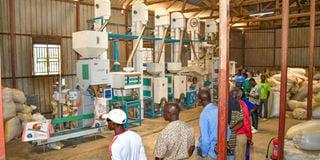
Rice processing in Doho irrigation scheme, Butaleja District. Agroindustrialisation could be the magic bullet for Uganda’s economic growth. PHOTO/MICHAEL KAKUMIRIZI
While Uganda’s economic managers are optimistic about the 2024/2025 national budget, some sector experts compare this confidence to expecting a perfect harvest in a season without rain.
After the devastation resulting from the Covid-19 pandemic, rendering a multitude of businesses, especially small and medium enterprises out of action, leaving nearly half a million people jobless, it seems, according to the government, that phase is not only long gone, but is also an indication of some light at the end of the tunnel.
According to the Finance minister, Matia Kasaija, Uganda’s economy has fully recovered from various internal and external shocks that impacted performance in the past four years.
The Finance Ministry data indicate that Gross Domestic Product (GDP), which is the country’s total economic production, is projected to have grown by 6 percent in the last financial year 2023/24 compared to 5.3 percent in the previous year - FY2022/23.
Last year’s growth of 6 percent, according to the Permanent Secretary and the Secretary to the Treasury, Mr Ramathan Ggoobi, also known for his mantra – economics that works, is far better than Sub-Saharan Africa’s average of 3.8 percent, and the global average of 2.9 percent projected for the year 2024.
As a result of this robust growth, the size of the economy is now estimated at Shs202 trillion or $ 53.3 billion, up from Shs184.3 trillion or $ 48.8 billion.
“If Ugandans agreed to share this GDP equally, each citizen would enjoy a GDP per capita of $1,146 (Shs4,250,665) compared to $1,081 (Shs4,009,571) registered last Financial Year 2022/23,” Mr Kasaija said while presenting the 2024/2025 budget speech about a fortnight ago.
Improved performance
The aforementioned performances are attributed to higher growth in key economic sectors such as services with estimated growth of 6.6 percent, agriculture at 5 percent, and industry showing growth of 5.8 percent in FY2023/24.
Growth in the services sector has been particularly impressive, driven by “strong recovery in retail and wholesale trade, tourism as well as communication and real estate activities,” according to the 2024/2025 budget speech.
As for industry, the growth was mainly driven by manufacturing, construction, and mining, while increased production of food and cash crops, as well as livestock, supported growth in the agriculture sector.
“Agriculture’s performance, estimated to have expanded at 5 percent this year compared to 4.5 percent registered in FY2022/23, is attributed to streamlined implementation of the Parish Development Model (PDM); and fairly good weather conditions,” according to Mr Kasaija.

Agroindustrialisation could be the magic bullet for Uganda’s economic growth. PHOTO/MICHAEL KAKUMIRIZI
Low inflation and relatively stable exchange rate, enabling good investment planning while supporting export competitiveness are also key elements in supporting economic growth. Other factors include increased investments in the oil and gas sector-related projects, supported by Foreign Direct Investment, and higher external demand for Uganda’s products, including agricultural and industrial products.
Economic drivers …
In this new financial year and in the medium term, economic managers say the country’s growth strategy is anchored on four key growth drivers; agro-industrialisation, tourism, mineral development including oil and gas, and finally Science, technology, and innovation (STI). These, according to the Ministry of Finance, are the anchor sectors that will propel Uganda into a 500-billion-dollar economy in the next one-and-a-half decades.
Tourism
According to the 2024 tourism report, Uganda’s international tourist receipts grew to reach Shs3.8 trillion ($1.025 billion) last year and are projected to earn Shs18. 9 trillion in the next four years.
“Tourism has the potential to generate more than $ 3 billion annually if it gets proper budget support. With the underfunding of the sector, we still managed to attract about 1.5 million arrivals into the country, yet we have the potential to attract 4 million or so arrivals which is also the target that has been given to the sector.
“But we need the funding of the sector to match the potential that tourism has.

Two male giraffes standing in an intertwined position in Murchison Falls National Park. Tourism has the potential to generate more than $ 3 billion annually if it gets proper budget support. PHOTO/ FILE
“With the African Cup of Nation coming up and proper promotion and advertisement of the country, tourism can be the game changer for the economy because it is a dynamic industry with so much potential that is yet to be fully tapped,” says Ms Jean Byamugisha, the chief executive officer of the Uganda Hotel Owners Association, the umbrella body for all the hotels in Uganda.
Double-digit growth
Next financial year, the economy is projected to get back to Uganda’s steady-state growth potential of between 6.4 and 7 percent, and double-digit over the next five years.
“Next Financial Year, 2024/25, Uganda’s GDP will further expand to Shs225.5 trillion equivalent to $60 billion.
“These numbers exclude the anticipated oil and gas revenues as well as the planned interventions to grow the economy tenfold,” Kasaija said.
When contacted last week, the director of research and advocacy at the Bank of Uganda, Dr Adam Mugume said for GDP to rise from the current $50 billion to $500 billion in the next 15 years, will require an annual growth rate of about 14 per cent year-on-year.
However, he is optimistic that this ambition is feasible.
He said: “This is attainable given that Uganda has basic infrastructure like power, road network linking most of the country, youthful and educated population, large market of EAC, Comesa and African Continental Free Trade Area, and the strategy is to add value to Agricultural production and minerals.”
He continued: “However, two major issues: First, project selection and implementation must be based on the sole objective of achieving the growth target rather than political economy.
“Projects must be properly conceived with clearly spelled out targets. The institutional setup must ensure success in implementation of the projects.”
Oil and gas
Uganda is progressing steadily towards the first oil in FY 2025/26. The planned 60,000 barrels per day Refinery in Kabaale, Kikuube District, is progressing well.
The government is working with Alpha MBM Investments from the United Arab Emirates (UAE) to build the Refinery. Since 2021, contracts worth $1.8 billion have been awarded to Ugandan companies, out of the total contract investment of $7.2 billion.
To continue with the progress in oil and gas development Shs920 billion has been provided for the oil and gas sector.

Increased investments in the oil and gas sector-related projects are expected to drive growth in Uganda's economy. PHOTO/FILE
On account of that, President Yoweri Museveni, speaking after Finance Minister Kasaija delivered the 2024/25 Budget Speech, notes that the potential for oil and gas is huge, stressing that the revenue gotten out of the sector will be invested in developing the country into a modern economy.
He said: “Once we start getting out our oil, the government will have $ 2 billion annually, just from oil alone, and that money will not be wasted but used in building important infrastructure.”
The director of policy and advocacy at Private Sector Foundation- Uganda, Dr Julius Byaruhanga. Last week, during a post-budget meeting, Dr Byaruhanga noted that the mining sector alone can generate about $620 billion annually, and with value addition, this can go to $2.4 trillion, which in a few years, can clear Uganda’s debt.




